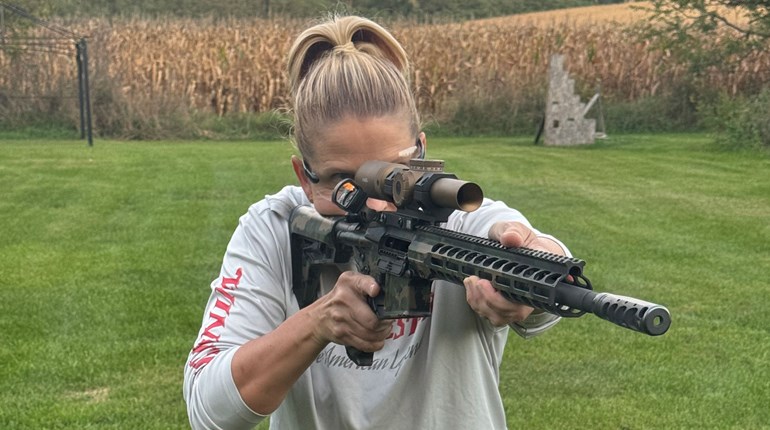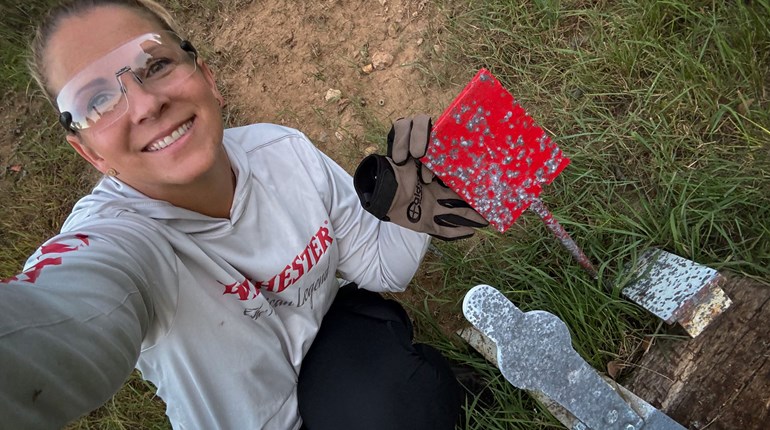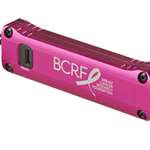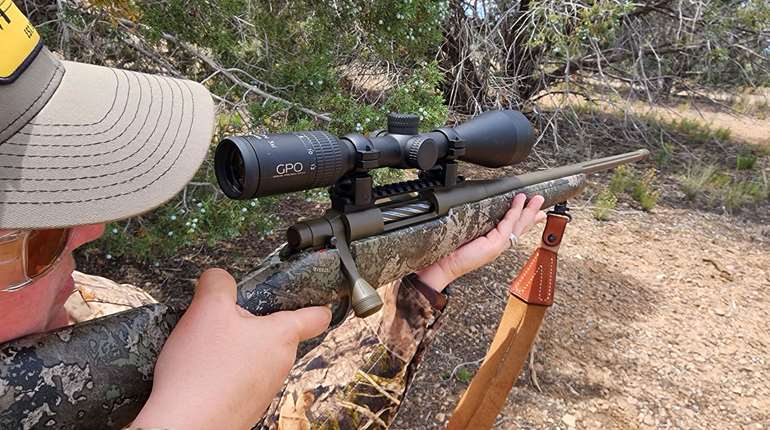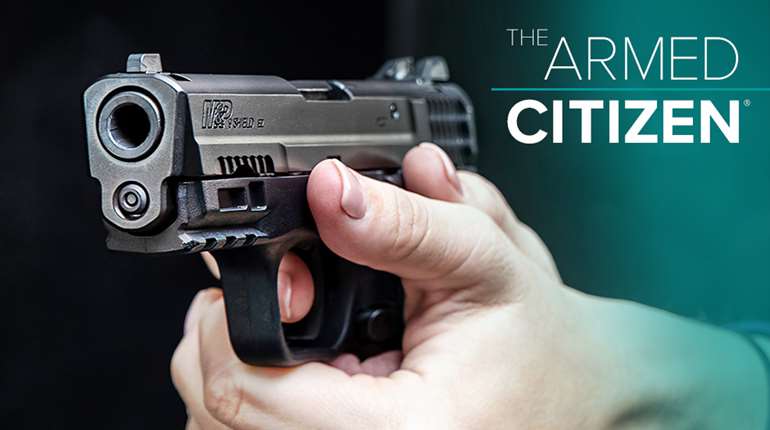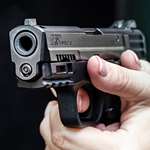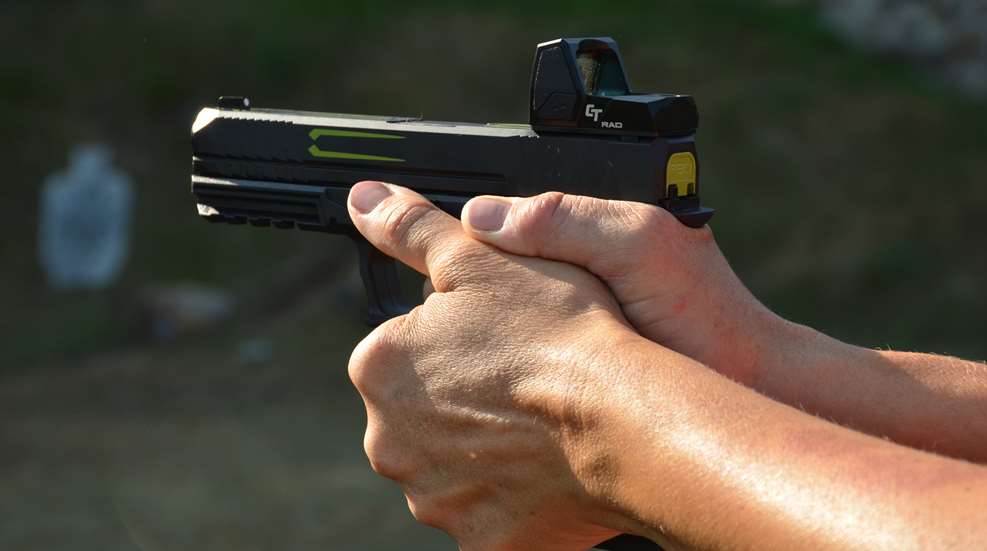
You don’t have to be a pro shooter to shoot like a champ—but advice from someone who shoots well can accelerate your learning curve and prevent you from building bad habits. Let’s look at 5 mistakes people make that can be fixed to help you enjoy shooting a handgun and build a roadmap to success.

Grip
How you hold and grip a handgun matters more than almost anything else when it comes to managing recoil and controlling the gun.

Your goal when gripping a handgun should be to hold it tight enough to control it during recoil, but not so tight that your hands are shaking. Your hands should be placed as follows:
Dominant or strong hand up as high as possible on the backstrap. No gaps at the top. Squeeze with grip with your fingers/palm, front to back, and try NOT to involve fingertips.

Support hand palm/base of thumb meeting the dominant or strong hand. Wrap the fingers over your dominant hand and squeeze. Again, try to minimize your fingertip involvement. Whether your grip is 50/50 70/30, 40/60 between dominant and support hand is all a matter of personal interpretation and style. What matters is that BOTH hands grip with strength.


Thumbs should ride one on top of the other for a semi-automatic or overlap for a revolver. (Variations in hand and gun size will make this something that can vary.)
Trigger Control
Trigger control is a term we hear often. To really understand it, you need to understand concepts like squeeze vs. snatch or slap, and visual patience. “Squeeze the trigger” is the phrase we tell new shooters. But what does that mean? Should we squeeze fast or slow? Where is our finger placed on the trigger? What do we do with our trigger finger after the gun goes off? There is much more going on than just squeezing the trigger until we fire the gun.

Ideally, the center of the pad on your trigger finger is on the center of the trigger. It might vary slightly from person to person (based on hand size and finger length) and where exactly on the trigger it sits might vary slightly as well for the same reasons. But in an ideal situation, you do what you have to do in order to pull the trigger straight back without causing your sights to become misaligned and move off the target.

The pressure used to squeeze the trigger should be even and controlled. Pause if your sights move off the target and continue squeezing as you move them back onto the target.
Whether you have a single-stage trigger or a two-stage trigger (one with a first stage of a little movement without much pressure, and then a “wall” where you finish squeezing until the gun goes off)—both types of trigger require you to take up the weight by squeezing it.
Experienced shooters will quickly reset the trigger by letting pressure off the trigger under recoil and beginning the process over as they come back onto target.
You can learn what it feels like to reset the trigger by using a simple drill: Insert a magazine in your semi-automatic pistol, and chamber a round. Then, drop/remove the magazine so that when you fire the round you will have an empty chamber. You will be able to feel the reset and dry fire afterward. This allows you to have a good sight picture and trigger press, and then feel what it’s like to reset the trigger under recoil and start the process over. For someone new to shooting a handgun or someone who does not understand trigger reset, doing this for a few magazines’ worth of ammo will be beneficial. The dry fire step will also help you understand if you are squeezing the trigger properly or “jerking” it.
Sight Alignment Vs. Sight Placement
The sights on your handgun being aligned is another important part of shooting a handgun well. You can have aligned sights placed poorly or barely on the target, and still hit it. But if you misalign your sights, your sight placement will only compound the misalignment, and can put you off the target. Here is the visual:

From left: Sights improperly placed on edge of target, and misaligned; sights improperly placed on edge of target, but aligned; sights properly placed on target and aligned.
Posture
Do NOT hunch or “turtle.” This is one item people mistakenly think will help them to manage recoil. Tensing your shoulders up, rounding them—what people call “turtle-ing”—is not a long-term strategy or proper form.. What you need to do instead is hold your shoulders down. People mistakenly say, “Relax your shoulders.” But we don’t actually relax; we’re not a limp noodle while we shoot. Two different ideas can help you set tension in your shoulders to help you manage recoil without “turtling.” 1) Think of the front sight of your handgun as having a string that’s tied to the ceiling. “Pull down” on that imaginary string at all times. That will create tension in your shoulders and the muscles surrounding them. 2) Another method is to have someone push up against your UNLOADED handgun while you try to keep the sights on target. Both of those should cause your shoulders to have tension in them as you try to pull that imaginary string down or keep someone from pushing your gun up. Hold that tension while you shoot and through recoil. You will recover and be able to return to target and shoot again, much faster.

Tensing your shoulders up, rounding them—what people call “turtle-ing”—is not a long-term strategy or proper form.

Have someone push up against your UNLOADED handgun while you try to keep the sights on target.
Understanding that handgun shooting requires technique and that people who do it well have mastered techniques is a stop on the road to being skilled with this particular type of firearm. It just requires time and a little thinking, and then a trip to the range.












